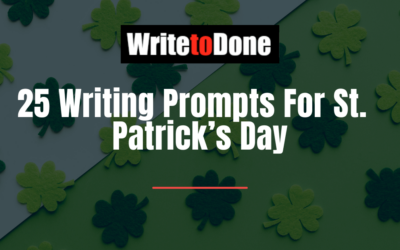You’re here because you write. You write because you love words. You love combining them to create sentences. You love writing for yourself, and you love writing for others. And now you have quite a bit of writing. You’ve put in the work. You have your writing samples.
And now you wonder what to do with them.
Writing portfolios are an invaluable way to keep track of your writing, but portfolios are also a simple way to present your writing to potential clients, other writers, and those who view your website.
Creating and maintaining a writing portfolio is similar to how photographers showcase their best work. Think of it like this:
A photographer gets an idea for a photoshoot, books a client, finds a location that fits his or her ideal aesthetic, sets up the time, meets the client, shoots the session, and returns home. Once home, it’s time to delete the photos that don’t add to the session, and edit the rest.
The same is true for you, the writer.
You have an idea. You create a location for your characters that fits your ideal story, article, or blog. You set time aside to write and fulfill your word count goal. Now it’s time to delete the words that don’t add to your writing, or in writers’ vocabulary, edit!
After all this work, it’s important to showcase your writing in a way that articulates who you are as a writer, your voice, your style, and your writing brand.
This way when a potential client asks to see your work, a publisher asks for previous articles before hiring you to write for their magazine, or your fellow writers ask for writing samples to learn and grow from, it’s all at your fingertips.
So, what is a writing portfolio?
What Are Writing Portfolios Used For?
In short, a writing portfolio is a collection of your best work created with the intention of showcasing it to clients, publishers, and writers, to create future writing opportunities.
Let’s say you’re a self-published writer attending a writing conference out of a desire to learn more about the craft. You work as a freelance editor and hope to land more editing opportunities.
You meet a fellow writer and strike up a conversation. They ask what you do, and when they discover you edit the very genre they write, they ask for samples of your work.
This is when you pull out your writing portfolio. You can have printed copies you keep with you and hand out upon request, or you can build a page into your website and even list the URL on your business card. Either way, you hand this writer a piece of paper (your portfolio and/or card), and they say they’ll be in touch.
Imagine for a moment that you hadn’t taken the time to create a portfolio. When this writer asked for samples of your writing you would have had to point them to your website blog or handed them a copy of your book.
This would showcase your work, but only a fraction of it and only a single genre or style.
What if you write nonfiction articles for various companies but only write fiction books? And what if this writer wants you to edit their nonfiction book but the only writing sample you have on you is the copy of your most recent fiction book?
Do you see how it’s essential to have a collection showcasing all your work?
Creating a writing portfolio can heighten your chances of landing more writing work because it shows who you are as a writer in every article, blog, or book you write.
What Should You Write In a Portfolio?
Ideally, you want to have a conglomeration of multiple examples of your current writing.
If you write articles for your Etsy shop, contribute to a writers’ writing website, have published fiction, and are working on your first nonfiction project, it would be helpful to include a selection from each style of writing: This will enable you to connect with a variety of people, from multi-genre writers, to potential clients in a variety of fields, to publishers.
If you’re just starting out, don’t be discouraged if you don’t have a large portfolio. Include your most relevant writing, and remember, it will continue to grow. Keep working at it!
If you’ve been at this for awhile, it may be a good idea to look through your portfolio and make sure all your writing samples reflect your current writing.
Writers grow and change, and it would be unfortunate to present an old piece of writing when it doesn’t showcase your current level of writing expertise.
However, you may have written nonfiction articles on marketing in the past, but moved on to write award-winning short stories on a regular basis. While your nonfiction articles may be older writing, as long as it still reflects your current ability and assuming you would still like to land this type of work, it would be wise to include a sample or two in your portfolio.
Freelance Writing vs. Creative Writing Portfolio
It’s essential to create your writing portfolio and fine-tune it to your exact area of expertise.
If you’re a freelance writer, writing for a variety of companies and focusing on SEO (search engine optimization), marketing, and branding, your portfolio should have a certain look and feel.
If you are a creative writer and publish short stories and fiction books or even series, your portfolio will have an entirely different look.
As a freelance writer, you will want to include your best work and content written for your most high-profile clients. Ideally these will be one and the same. Consider including the name of the client you worked for in the footer (this does not apply to ghostwriting).
As a creative writer, include your award-winning short stories, contests made finalist in, and the first chapter or so of your best fiction book.
Organize these in chronological order for clarity.
Whether you are a freelance writer for other companies, a creative writer working for yourself, or a traditional editor working for a publisher, make sure it is clear to viewers.
Just as it’s said to think reader first when writing, for best results, think viewer first when creating your writing portfolio. When someone opens your portfolio, either on an actual page or on the web, it’s important that your writing stands out. This means it should be organized in a way that is helpful to the viewer, rather than distracting. Avoid too much design and keep it smooth, simple, and straight-forward for easy reading.
How to Create a Writing Portfolio
Your personal writing goals will determine where you publish your portfolio, so let’s talk about a variety of methods and ensure you make yours the best it can be.
1. Your To-Do List
First, look at your previous writing. Some places to look would be your writing website, any guest blogs you’ve written, written interviews you’ve conducted, writing contests you’ve entered, any smaller publications you’ve written for, books you’ve written, etc.
Anything you’ve written, track it down.
Next, decide how far back you want to go. For instance, you won’t want to include your first blog posts unless you’re just starting out and those are therefore current writing samples.
Note: If you write blogs with numerous photos, consider cutting these unless they are absolutely essential to your writing. Photos take up valuable space and make your portfolio bigger than necessary. If you choose to print your portfolio and hand out copies, photos will take up quite a bit of ink and make your portfolio that much thicker for someone to handle.
Once you’ve decided how far back to collect samples, choose your standout work: If you’ve entered 45 writing contests but made finalist in 3 and won 1, choose from the latter options.
After this, you’ll want to read through any writing samples you can still edit and will include to make sure you didn’t miss any typos.
Once you’ve decided what to include, it’s time to determine how and where.
2. How To Organize It
Organizing your writing is much more straightforward than you may think. You can organize it by genre (fiction, nonfiction, guest posts, blogs, award-winning writing, etc.) or by date.
If you have seven genres and one sample per genre, you may want to organize it by date. If you have two genres and three pieces per genre, you may want to organize it by genre with the best work at the front.
However you decide to organize your work, make sure it flows well, is easy to read, and showcases you and your writing.
3. Where To House It
If you are an award-winning writer with an author website, you may want to dedicate an entire website page to your writing portfolio.
However, if you are a freelance writer looking for work, creating a Google document folder with subcategories may be more conducive to your current writing goals.
First, let’s talk about creating a website page. A simple way to do so is create a new page and hide it while it’s under construction, label it YOURURL/portfolio and then create buttons opening new pages organized by date or genre, or a scrollable page, labelled accordingly.
Once your page is complete, you can choose to link it on your site for any viewer to look through, or send the direct link to potential clients on an as-needed basis.
Second, if you’re just starting out and don’t have a website yet, or simply want to use a Google document folder, this is also an easy step.
You can create one document, perhaps with a title page, or create one folder with many documents inside. Whatever you choose to do, don’t forget to make it shareable with anyone who has the link, so that when a client asks for your writing samples, they can easily access it.
4. Send It Off
You did it! You have a writing portfolio. Now it’s time to send it out into the world. This can be nerve-wracking, but remember, you can always edit your portfolio. It should be a work-in-progress because it is a showcase of your best writing.
As you grow and change as a writer, so should your portfolio.
Clients will likely give feedback, intentionally or unintentionally, and this will help you continue to revamp and fine-tune your portfolio, making it shine.
Wherever you choose to house your portfolio, whoever you send it to, and whatever you include or don’t, remember this is your work. It showcases you and your efforts.
Be proud of it.
You put in the effort. It’s time to put yourself out there for more writing opportunities. This is something to celebrate.
Best wishes!
















